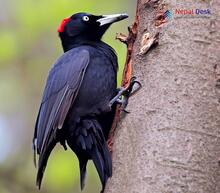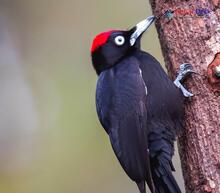Dryocopus: Exploring the Enigmatic Woodpeckers of Nepal
Nestled in the heart of the Himalayas, Nepal is a breathtaking haven for diverse flora and fauna. Among its fascinating inhabitants is the elusive and striking Dryocopus woodpecker. Here, we will delve into the world of Dryocopus, shedding light on their classification, common features, evolutionary relationships, and nomenclature.
Classification: A Vital Part of Avian Biodiversity
Belonging to the Picidae family, Dryocopus species share a close bond with other woodpeckers. The genus comprises several distinct yet closely related species spread across various geographical regions. In Nepal, these captivating birds contribute significantly to the country's vibrant avian biodiversity.
Common Features: Unveiling the Secrets of These Enigmatic Birds
Dryocopus species are characterized by their sturdy build and striking plumage that often features a combination of black and white or red patterns. Their strong, chisel-like beaks equip them to peck into tree trunks in search of insects and larvae, while their sharp claws and stiff tail feathers provide support as they navigate through tree branches.
These woodpeckers possess remarkable auditory senses and exceptional head-banging abilities that aid them in detecting prey beneath the bark. Interestingly, their unique skull structure prevents any damage from these forceful impacts. Moreover, Dryocopus woodpeckers play an essential ecological role as natural pest controllers in forests across Nepal.
Evolutionary Relationships: Unraveling the Threads That Connect Them
To understand the evolutionary relationships between Dryocopus species in Nepal and their global counterparts, scientists use sophisticated genetic tools such as DNA sequencing. Comparative studies of mitochondrial genes have offered valuable insights into how various woodpecker species emerged over time, adapting to different environments. As research progresses, our knowledge about these enigmatic birds will only grow deeper.
Nomenclature: The Significance of Names
The scientific nomenclature of Dryocopus woodpeckers not only highlights their genus but also reflects their unique characteristics, geographic distribution, and relevant history. For instance, the "Dryo-" prefix is derived from the Greek word for tree, alluding to their arboreal lifestyle. Meanwhile, the "-copus" suffix originates from the Greek term for a blow or strike—a nod to their impressive pecking prowess.
Unlocking the Mysteries of Dryocopus in Nepal
As we continue to explore the complex world of Dryocopus woodpeckers in Nepal, many captivating mysteries await us. From their intriguing classification to their distinct features, evolutionary relationships, and apt nomenclature, these charming birds serve as fascinating subjects of study while contributing to Nepal's rich biodiversity.




